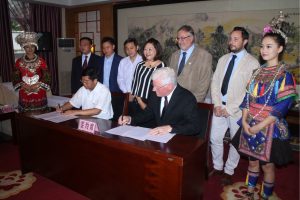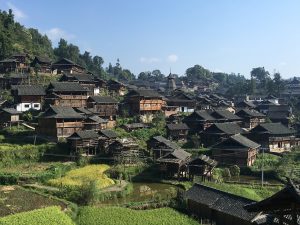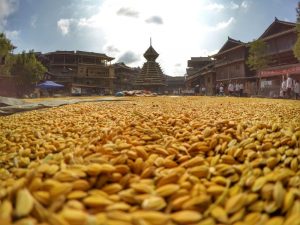2017 China (Qiandongnan) International Folk Song Choral Festival and IFCM World Voices Conference, August 8-13, 2017, Kaili City, Guizhou Province, China
Angelina Vong and Yong Mao
“Come to Kaili (Guizhou, China), listen to the folk songs of the world.” Experience the folk music of the orient, as we explore the city of Kaili and its surrounding villages along with the folk music from around the world. IFCM is also pleased present the IFCM World Voices Conference to take place at the same time. Read on to learn about the Dong minority and songs, the festival, and the IFCM World Voices Conference.
The Dong Ethnic Minority is one of the official 55 Chinese ethnic minorities with a population of approximately 3 million people. Similar to other Chinese minorities, the Dong people live in neighbouring provinces in southern China, with their own language, and folklore. The Dong people speak Kam, which is classified within a branch of the Sino-Tibetan linguistic family, but they also understand Mandarin.
Dong’s Three Treasures
Those whom are not familiar with this ethnic minority will find it to be one of the most interesting in China because of its rich and abundant culture. Most of the Dong (also known as the Kam, Tong, or Tung) culture revolves around song and dance. One of their “Three Treasures” is that of the Grand Songs, a form of folk music.
Grand songs, Al Laox or Dong Chorus, were established along rivers or reservoirs, and it is a unique folk singing tradition widely practiced by the Dong people. The term Al Laox means grand and ancient songs, and takes form in a unique a cappella. Each singer plays an important but small role in the group and they need to have a precious sense of absolute pitch. Most singers receive very strict training from their parents or grandparents from a young age. In most cases, these a cappella groups are formed within one family, allowing family history, poems and stories to be handed down from one generation to the next.
Grand Songs usually feature various rhythms, elegant melodies, and beautiful lyrics to deliver profound meanings. The lyrics usually apply metaphors and analogies to celebrate romance, relationship, friendship, nature and labour. However, in Grand Songs that imitate nature one might also hear the sounds of warbling birds, babbling brooks, or buzzing cicadas. Grand Songs are different depending on the category or occasion, thus each song has a time, place and situation in which to be sung.
Having been systematically passed down for thousands of years, the Dong music helps to pass on culture, build ethnic cohesion, express emotions, and even find romantic dates. Perhaps the lack of a noun for music in the Kam language reflects the significance of music in their lives. Singing and music is in their blood and their language, and they have become synonymous with each other. Instrumental music has also become an appendix of the vocal one. Almost all instruments they play have something to do with singing.
Dong Drum Towers display the musical talents of the Dong people in festivals. There are Dong festivals throughout the year, which provide opportunities for singing competitions, dances, opera plays, water buffalo and bird fight contests, marriages, rituals, and ceremonies. In an ancient custom, on the eve of a festival, the young men of a village go to invite out unmarried young girls from a neighbouring village. Dressed in their luxuriously woven and embroidered clothing, adorned with handmade silver bracelets, and holding flutes, pipas (short-necked Chinese lutes, Editor’s note) or drums, the girls invited follow the young men back to their village’s drum tower for a rich feast. Then, sitting in parallel rows, facing toward each other, the young men and women sing their songs to get to know one another until dawn. Along with the singing, flutes, pipas, drums, and other traditional instruments are part of the performance. The next morning, the young girls go back to the drum tower of their own village. One can see that even in courting the opposite sex, singing plays an important role in their lives.
The Dong’s unique carpentry skills are exhibited through fabricating their unique bridges, a key cultural relic under national protection. The public bridges, known as wind-rain bridges, are beautiful, large-scale, wooden, covered structures that can be found both outside and inside Dong villages. In particular, the peaceful bridges around the Dong villages are so attractive that they make for mesmerizing exploration. A Dong village may have several wind-rain bridges that are built with special “shelters” to keep out wind, rain, or unwelcomed weather for weary visitors. Those “shelters” are pavilions with attractive decorations built on the bridges, and some of them have become temples (pagodas). In the southern Dong region, small bridges, also called flower bridges, are exquisite structures adorned with dragon and phoenix carvings and maybe built on the ground without crossing a river. The temples are not just places for the local Dong to worship their gods, but they also facilitate earthly activities, such as socializing, amusement, or lovers meeting under the moonlight.
Most of Dong’s constructions are believed to have been built according to a Chinese ancient philosophical system called Feng Shui, literally Wind-Water in English. The power of Feng Shui harmonizes and balances all the elements within the surrounding local environment in keeping with important Chinese metaphysics. Taken for granted, the wind-rain bridges are built to match all the requirements, including the choice of their location, to channel the power of Feng Shui and to protect the village’s fortune.

Protection of the Dong Heritage
The Grand Songs of Dong Chorus were first introduced internationally at a music festival that took place in 1986 at the Chaillot National Theatre in Paris. It was the first time that the world has heard the polyphonic music of the Dong. In 2005 and 2009 respectively, the Grand Songs of Dong have been included in China’s National Intangible Heritage List and UNESCO’s World Oral and Intangible Heritage List. It is heartening to see that the Dong Chorus is now classified as a protected subject matter. At the same time, the Chinese government has realized the urgency of protecting this very fragile oral tradition. As the most famous gathering place for Grand Songs, Xiaohuang Village was chosen to be the best location to build the Dong Chorus Museum. The completion of this museum has been playing an important role in shaping a sense of cultural identity and boosting an awareness of cultural protection.
For over 2500 years, the Dong have practiced and passed down their folk tradition through song. A famous Dong proverb says: “Food grows the body; singing nurtures the heart”1 showing the indispensable value of singing in their daily life. As you make your way this August to Kaili, China, explore the centre of southern China’s unique landscape, exceptional scenery, and multi-cultural folklore.
2017 China (Qiandongnan) International Folk Song Choral Festival
8-13 August 2017 in Kaili, Guizhou Province, China, the folk song heritage will be heard by the world. Since most Dong prefer their towns or villages to be relatively small (usually 20 to 30 households constitute a village), Dong songs vary from village to village. One may discover that popular songs from neighbouring villages can be quite different. Since one cannot easily travel to the Dong villages, this is the perfect opportunity for international choral folk music lovers and culture enthusiasts to explore this interesting and unique heritage. Not only will you be able to hear the songs of the Dong and Miao people of this region, but you will be able to explore some world renowned choirs singing folk songs indigenous to their own countries.

IFCM World Voices Conference
The International Federation for Choral Music is proud to present this year’s World Voices Conference to be held in Kaili, Guizhou Province, China, in conjunction with the 2017 China (Qiandongnan) International Folk Song Choral Festival. The World Voices Conference is a unique festival and conference. It is a unique opportunity for people who are culturally anxious to discover new worlds and new voices. It is the perfect occasion to learn from conductors, musicologists, composers, singers, musicians, students and music and culture lovers.
The main objective is to spread the results of academic research and best practices by letting people from outside the academic world discover the content, whys and hows of a culture, a musical period, and a way of singing. The previous IFCM World Voices Conference took on the subject of Mediterranean culture, and this upcoming conference will focus on oriental culture. This is an opportunity not to be missed for choristers, conductors, and scholars.
Angelina Vong is the Administrative Director for the Macau Choral Arts Association. A volunteer for IFCM since 2011, she has been involved in a number of projects with IFCM including assisting the Asia Pacific Youth Choir and the IFCM World Choral EXPO. She continues to find opportunities to help bring people together through choral music. Email: angelina.vong@hotmail.com
Yong Mao is a doctoral candidate in choral conducting at the University of Oklahoma. Meanwhile, he is working as a volunteer for IFCM and other non-profit choral organizations. Prior to pursuing a degree in choral conducting, he completed a bachelor’s degree in electrical engineering at Tianjin University and worked as an assistant conductor of the Peiyang Chorus. In 2007, he was selected as one of the world’s most promising young choral conductors by IFCM. Email: 6voices@gmail.com
Edited by Mirella Biagi, Italy/UK

